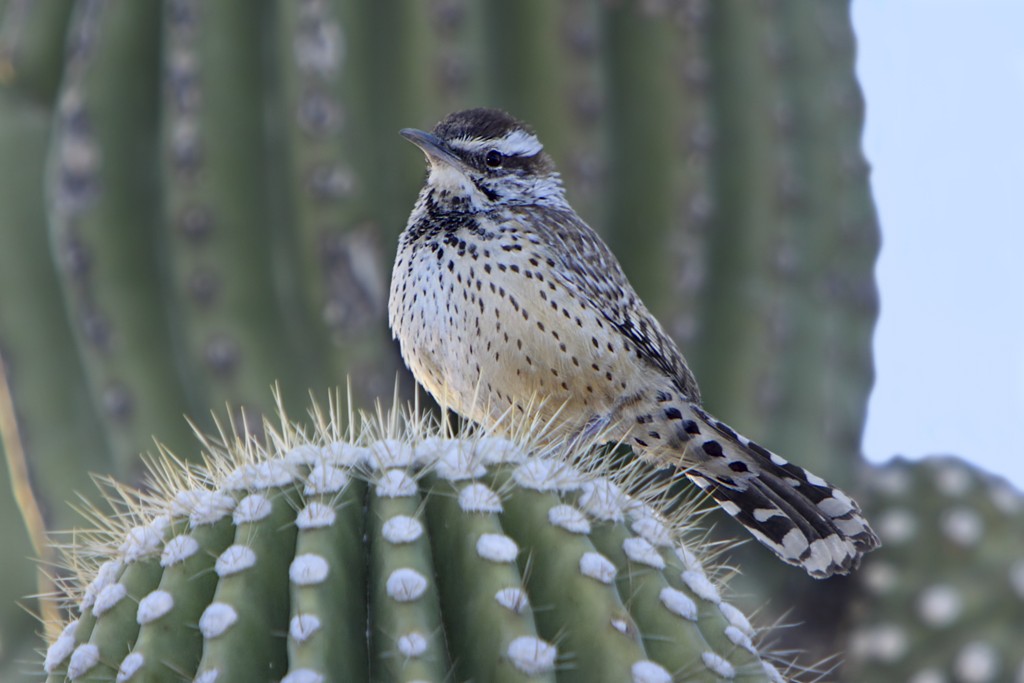Cactus Wren
A species of Cactus Wrens Scientific name : Campylorhynchus brunneicapillus Genus : Cactus Wrens
Cactus Wren, A species of Cactus Wrens
Botanical name: Campylorhynchus brunneicapillus
Genus: Cactus Wrens
Content
Description People often ask General Info
Description
The cactus wren is the largest wren in the United States. It is between 18 and 19 cm (7.1 and 7.5 in) long, and weighs between 33.4 and 46.9 g (1.18 and 1.65 oz), with an average of 38.9 g (1.37 oz). It has a thick, heavy bill that is dull black, curves slightly downwards, and is about the same length as the head. The lower mandible is grayish and pale, and the tail is long and rounded. The cactus wren's coloration is brown with white speckles. The crown is chocolate-brown with a light red tinge. A distinctive white supercilium (eyebrow) runs from the bill to the nape of its neck, which is brown with white markings. The chin is white, while the neck has black markings on a mostly white background. Their chest is white with brown or black speckles, and the belly is generally white with some brown or black streaks. The rump and back are gray to brown with white and black streaks. Both the lower underparts and the flanks are cinnamon-buff colored. The cactus wren's ten primary and nine secondary flight feathers are barred, alternating between black and off-white. Its twelve rectrices are barred, alternating between brownish-black and pale gray-brown. The outer rectrices are white tipped. When flying, a white band can be seen on the underside of the tail feathers. The tail is barred in alternating stripes of black, white, and brown. The legs are brown to pink-brown. Males and females look alike; juveniles can be distinguished by their paler coloration and red-brown to muddy-gray eyes. Adults have more red-brown to red eyes. Other distinctive features of juveniles include the lack of a white nape streak, and less noticeable black chest markings. Summer often takes a harsh toll on plumage; the intense desert sun and prickly vegetation fade and damage feathers. This wear and tear can make identification of juveniles more difficult. Worn feathers are replaced by molting, which happens in adults from July through October, usually in the bird's own territory. Not all feathers will molt in a single season. Although the cactus wren looks similar to other wrens in its genus, cactus wren identification is made easier since the habitat of Campylorhynchus wrens does not overlap. A notable difference that can assist in identification of the cactus wren is the white tail band seen in flight. The spotted wren looks similar, but is paler and has fewer markings, and its habitat is in oak woodlands (where cactus wrens do not usually live). 
Size
18-23 cm (7-9 in)
Colors
Brown
Black
Yellow
Gray
White
Life Expectancy
6 years
Nest Placement
Shrub
Clutch Size
2 - 7 eggs
Incubation Period
1 - 3 broods
Number of Broods
16 - 17 days
Nestling Period
17 - 23 days
Feeding Habits
Cactus Wren mainly consume insects, including beetles, ants, wasps, grasshoppers, butterflies, and spiders. They forage by overturning debris on the ground, on tree bark, and in bushes. They also eat seeds, fruits, nectar, and occasionally small reptiles. Cactus Wren obtain most of their hydration from their diet, notably cactus fruits and are known to drink sap from cacti. They can survive without standing water, adapting to hot environments by feeding in shaded, cooler areas. Parents feed young insects, sometimes removing parts for easier consumption.
Habitat
Cactus Wren predominantly inhabit arid and semi-desert regions, nesting within spiny cacti in the Sonoran and Chihuahuan Deserts, from sea level to elevations up to 2,000 meters. Preference is shown for an environment rich in desert vegetation such as cholla, saguaro, prickly-pear, mesquite, and acacia. Their habitats extend from coastal scrublands to interior deserts across the southwestern US and Mexico, showing no migration.
Nest Behavior
Female cactus Wren selects the nest site, and both sexes construct it in 1-6 days, with most activity in the early morning. After nest completion, the egg-laying and shared parental care follow.
Nest Characteristics
Cactus Wren's nests are football-shaped constructions built 3-10 feet off the ground amidst thorns of cholla, palo verde, acacia, or mesquite. They are 7 inches in diameter and 12 inches long, weighing 6 ounces. The small entrance requires a 'doorstep' or perch, leading to a widened interior lined with feathers.
Dite type
Insectivorous
People often ask
General Info
Feeding Habits
Bird food type

Hulled Sunflower Seeds

Suet

Peanut Hearts

Mealworms
Bird Feeder Type

Large Tube Feeder

Suet Cage

Large Hopper

Small Hopper

Platform

Ground
Sounds
Call
Recording location: United States
Call
Recording location: United States
Song
Recording location: United States
Song
Recording location: United States
Behavior
Cactus Wren display a high level of daytime activity, frequently foraging in open areas and seeking shade during hotter periods. They are known for their distinctive presence, often observed singing from prominent perches and moving about the ground with a jerky, fluttery flight. Intriguingly, cactus Wren utilize their nests throughout the year, retreating to these structures after dusk. While their flight is not particularly strong, featuring a combination of swift wingbeats and gliding, they are thorough in their territory defense. Aggressive behaviors such as feather fluffing, tail spreading, and vocal scolding are common responses to intruders, escalating to mobbing in the face of predators like snakes. Sociable yet territorial, these birds strengthen pair bonds with unique growling vocalizations and gentle pecking gestures. During breeding seasons, which are typically annual unless environmental conditions dictate otherwise, cactus Wren may produce multiple broods.
Distribution Area
The cactus wren is a bird of arid and semi-desert regions, and generally requires spiny cactus to nest in. Its range includes the Sonoran and Chihuahuan Deserts. The cactus wren is not migratory, and establishes a permanent territory which it defends vigorously. Territories are typically 1.3 ha (3.2 acres) to 1.9 ha (4.7 acres). The size and shape of territories change very little throughout the season. Territory is defended from other birds by fluffing tails and feathers and vocal scolding. Persistent trespassers may cause the wrens to give chase. The cactus wren is only found in the United States and Mexico. In the U.S. it is present in California, Nevada, Utah, Arizona, New Mexico, and Texas. In California it is found mainly as southern coastal populations existing below 600 m (2,000 ft), but some have been found up to 950 m (3,120 ft). Nevada represents the northernmost extent of its range: it is found in the southern tip of the state; the northernmost breeding population is found in Nye County, near Tonopah. In Utah it is found only in the extreme southwest. Its range in Arizona is widespread in the southern part of the state, and along the Colorado river. In Arizona it is found from sea-level up to 1,400 m (4,600 ft). Populations in New Mexico exist in the south, down to along the Rio Grande and into Mexico. Its range in both New Mexico and Texas may be expanding northward. Texas cactus wrens live between sea-level and 1,800 m (5,900 ft), throughout the Texas panhandle, central Texas, and as far east as Travis County. In Mexico it is found in Sinaloa, Sonora, Chihuahua, Coahuila, Neuvo Leon, Hidalgo, and throughout Baja California. On the Central Mexican plateau and in New Mexico it is found up to 2,000 m (6,600 ft). Populations may be expanding their range in Baja California, but they are not found in the mountains or interior of Baja. 
Species Status
Not globally threatened.
Scientific Classification
Phylum
Chordates Class
Birds Order
Perching birds Family
Wrens Genus
Cactus Wrens Species
Cactus Wren 